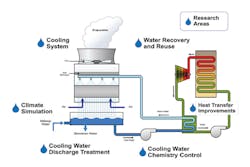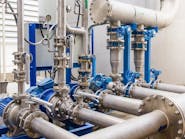Considering industrial cooling systems and heat transfer process improvement
Water plays a vital role in fossil and nuclear electric power generation plants, which require large quantities of water, primarily for cooling systems. The Electric Power Research Institute (EPRI) estimates thermoelectric consumption of fresh water for cooling in the U.S. is 3 to 4 percent of total withdrawals, which is equivalent to 3.9 billion gallons per day. Power plants also discharge water that is no longer usable and must comply with federal and state standards and regulations for effluent.
In the future, stakeholder pressure and new regulations are likely to continue to increase water management restrictions for all electricity generating units, including nuclear, natural gas, coal and renewable plants. Across a range of governing agencies, new goals are expected to be outlined to address long-term issues and prevent shortages in water supply and disruptions in electricity generation.
For the energy sector, these goals include the elimination of freshwater consumption in water-stressed areas, minimized freshwater degradation, more efficient electricity use, and integrated management in the water supply and wastewater sectors. Regulatory changes could force limitations on the withdrawal and consumption of freshwater, which could have significant negative impacts on efficiency and operating costs and will require technology breakthroughs in cooling and heat transfer. Timing is also a concern because the future of water regulations is uncertain and could outpace technological developments.
Cooling systems for electricity generation
Systems for cooling power plants today include many options:
- Once-through cooling systems withdraw water from a natural source (typically a lake, river or ocean), use it to extract waste heat from the steam cycle, and then return it to the body of water at a slightly elevated temperature.
- Recirculating cooling system water in a tower or pond and sending the water to the condenser.
- Dry cooling systems use air rather than water to condense the steam, which is piped from the turbine to air-cooled condensers. Although dry cooling systems achieve large water savings, their initial cost is three to five times that of wet cooling systems, and their operating power requirements for cooling system pumps and fans are 1.5 to 2.5 times higher than wet cooling systems.
- Hybrid cooling systems configure dry and wet loops in parallel to cool the recirculating condenser water. These systems reduce cooling water volume by using dry cooling during cooler periods and wet cooling during hotter periods when dry systems cannot maintain low turbine exhaust pressure.
EPRI’s Water Management Technology Program
EPRI’s Water Management Technology Program, launched in 2013, evaluates the performance, operability, reliability and cost of advanced cooling technologies designed to reduce water withdrawal and consumption while minimizing the impact on a plant’s thermal efficiency. These cooling technologies (such as cooling water systems) are applicable worldwide and equally to Rankine steam boiler and gas-fired, combined-cycle units. To reduce water consumption, the program evaluates processes to recover moisture from the flue gas and to enable the reuse of wastewater streams within the power plant by removing species that cause scaling and/or corrosion.
EPRI’s Water Management Technology Program, launched in 2013, evaluates the performance, operability, reliability and cost of advanced cooling technologies designed to reduce water withdrawal and consumption while minimizing the impact on a plant’s thermal efficiency.
The program also identifies, evaluates and demonstrates cost-effective and reliable treatment technologies to limit pollutants discharged from a power plant.
The program utilizes the Water Research Center, located at Georgia Power’s Plant Bowen, to support proof-of-concept pilot tests and, when possible, near-commercial-scale system studies. The center, which was developed by Georgia Power in collaboration with EPRI and supported by 12 utilities, offers electric generating companies, research organizations, and vendors access to full-scale infrastructure, treatable water, monitoring and analysis facilities. The center also offers vendors access to specialist staff to enable plant-based water research studies.
Since the program’s inception, its research has addressed plant water balance models, advanced cooling technology evaluations and water treatment developments. Focus on hybrid cooling has resulted in two demonstration projects at the Water Research Center. In the area of water treatment, several technology developments have centered on improving treatment of flue gas desulfurization (FGD) wastewater, which is under new requirements from the U.S. Environmental Protection Agency (EPA). Additional projects involving membrane techniques and innovative thermal evaporation have shown promise in highly concentrated wastewater streams, which indicates they could be applied to many potentially difficult-to-treat chemistry applications.
Advanced cooling systems research
In the electric power industry today, cooling research is being conducted in a variety of areas, including heat transfer and cooling water discharge treatment. However, research is generally focused on the two ends of the technology readiness level (TRL) spectrum. At one end, the federal government, national labs, universities and EPRI’s Technology Innovation Program are conducting basic research on early breakthrough technologies (low TRL). At the other end, the private sector is sponsoring demonstrations of technologies closer to commercialization (high TRL).
EPRI’s Water Management Technology Program, therefore, is seeking to accelerate technology development and implementation by expanding the program’s current capabilities and conducting research in the gap in the middle – between early breakthroughs and the later, larger-scale demonstrations near commercialization.
EPRI’s expanded research will incorporate a new Cooling System and Heat Transfer R&D Test Center. This center is intended to be a world-class facility to address mid- to long-term needs in power plant and industrial cooling applications. It will serve as an industry resource specifically dedicated to cooling and heat transfer improvements, such as cooling water systems (pictured above).
The test center will conduct research in the following areas:
- Advanced and alternative cooling systems (in addition to cooling water systems)
- Heat transfer improvements
- Cooling water chemistry control and discharge treatment
- Water and moisture recovery
- Supporting activities related to materials, sensors and controls
The new cooling research center will provide infrastructure for testing and evaluating technologies in real-time conditions. Access to common equipment and resources such as heat exchanger tubes, cooling towers/systems, a climate control and simulation system, and cooling water sources will allow research staff to conduct a variety of research and development (R&D) projects.
One project being considered for the new center is a cooling technology case study, which will document the current state of available cooling and heat transfer technologies at an electricity generation station. The evaluation will include the potential for water savings and efficiency improvements associated with the adoption of available technologies, along with total cost considerations (capital, operations and maintenance) and the impacts on generation efficiency. Results from the case study are intended to support the research areas and demonstrate how the new center would support long-term R&D needs.
For advanced cooling water systems, research could explore technologies to improve the efficiency of traditional air-cooled systems and technologies to enhance the performance of steam surface condensers and auxiliary/service water cooling in hybrid systems.
Heat transfer improvement research could focus on historic problems with steam condensers, including tube fouling, tube scale, the longevity of tube materials and heat transfer issues. Among the potential improvements to be explored are coatings and surface enhancements, non-stick surfaces (water side), hydrophobic surfaces (steam side), and rifled tubes. Research will study the effect of improvements on plant performance and plant operation and maintenance. If successful, the surface technologies could lead to 0.15 to 0.4 percent improvement in plant heat rate.
Research on cooling water chemistry control could address challenges from corrosion and mineral scale deposition, microbiological fouling and suspended solids accumulation. It could also evaluate alternatives for phosphorus-based treatment for mineral scale, assess alternative makeup water sources, and study the characterization and treatment of blowdown water.
The goal for the Center is to complete construction and have a fully operational facility in the third quarter of 2018.
Jeffery Preece is a senior technical leader at EPRI. In this role, he is responsible for planning and managing power plant water management R&D projects for Program 185: Water Management Technology. These areas include water requirements for environmental controls, increasing efficiency of water use and addressing water treatment issues. Preece may be reached at [email protected] or 704-595-2870.
Richard Breckenridge is a senior project manager in the Generation research sector at EPRI. He is a technical lead for EPRI’s research in water management technologies – such as advanced cooling, water and wastewater treatment within the power plant, water balance and optimum use models, and water conserving technologies. Breckenridge may be reached at [email protected].




